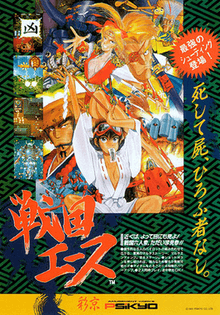Samurai Aces
Sengoku Ace (Sengoku Ace (戦国エース, Sengoku Ēsu)), fully titled Sengoku Ace: Tengai Episode I and also known as Samurai Aces in the English version, is a vertically-scrolling shoot 'em up video game originally released in the arcades by Psikyo in 1993. The first game by Psikyo, Sengoku Ace was designed by Shin Nakamura, the creator of Aero Fighters (Sonic Wings) and the company's founder.
| Sengoku Ace | |
|---|---|
 Japanese arcade flyer | |
| Developer(s) | Psikyo (Arcade) APXSoft (Mobile) |
| Publisher(s) | Banpresto (Arcade) Taito, 505 Games (PS2) Noritong (Mobile) |
| Designer(s) | Shin. Nakamura |
| Artist(s) | Hirofumi Nakamura |
| Composer(s) | Masaki Izutani Kouji Murata |
| Series | Sengoku Ace |
| Platform(s) | Arcade, PlayStation 2, Mobile, Nintendo Switch |
| Release | April 22, 1993 (Arcade) December 2, 2004 (PS2) February 15, 2018 (Switch) |
| Genre(s) | Scrolling shooter |
| Mode(s) | Up to 2 players (co-op) |
| Cabinet | Vertical |
| Arcade system | Psikyo 1st Generation |
| Sound | Yamaha YM2610 |
Gameplay
Plot
Story
The science fantasy story of Sengoku Ace resolves around the six Feudal Japan (Sengoku period) characters sent on a mission to stop an evil cult and rescue the Shogun's kidnapped daughter, princess Tsukihime (Moon Princess), before she can be used as a sacrifice to resurrect their demon god. The game features 21 endings, different for various characters and two-player pairings.[1]
Characters
- Flush (Flash) / Ayin / Aine (閃光のアイン) - A 25-year-old, one-eyed, blonde samurai flying a J7W, who is looking for his sister Asuka. He is voiced by Hisao Egawa.
- Gen / Gennai (からくり屋 源内) - A 77-year-old scientist with a small robot assistant named Ranmaru, who flies a small, agile "Super Fighter" plane that resembles an X-wing starfighter from Star Wars. He is voiced by Daisuke Gōri.
- Jane Hayate (はやてのジェーン) - A 21-year-old blonde and blue-eyed beautiful female ninja who flies a glider. She is voiced by Hiroko Emori.
- Kenno (Kenno Maru) / Kenoumaru / Ohmaru (犬王丸) - A "super genius dog" flying a high-tech YF-23 aircraft (according to some of his team play endings, really a young man sealed in a dog form).
- Miko / Koyori (Koyori Togashi) (富樫こより) - A 17-year-old miko with a fascination for money, who flies a biplane. In Sengoku Ace, Koyori is still very young and tomboyish. She is also voiced by Hiroko Emori.
- Tengai (Tengai Kano) (ターボ坊主 天外) - A 50-year-old Japanese Buddhist wandering monk who flies a bizarre bird-like plane. He is also voiced by Daisuke Gōri.
Release
Sengoku Ace was released in the Japanese arcades on April 22, 1993. In December 2004, the game was ported to PlayStation 2 as part of the Psikyo Shooting Collection Vol. 2: Sengoku Ace & Sengoku Blade by Taito and 505 Games. It also was re-released one year later as a budget-range title. In 2018, it was also released for the Nintendo Switch.
The original and arranged soundtrack for the game (GCD-1) was released by Shinseisha on January 22, 1994.[2] The game's manga adaptation titled Sengoku Ace - Ataru Kadiba (戦国エース - かぢば あたる) (ISBN 4-88199-140-X) was published by Shinseisha in the Gamest Comics series on December 25, 1994.[3]
Reception
In Japan, Game Machine listed Samurai Aces on their June 1, 1993 issue as being the fourth most-successful table arcade unit of the year.[4]
Brazilian magazine Ação Games gave it 9/10.[5]
Legacy
Sengoku Ace was followed by two sequels, Sengoku Blade: Sengoku Ace Episode II in 1996 and Sengoku Cannon: Sengoku Ace Episode III in 2004. The Sengoku series characters, along with the ones from Psikyo's Gunbird series, later joined up with several Capcom characters (especially from the Street Fighter fame) in the crossover game Taisen Net Gimmick: Capcom & Psikyo All Stars,[6][7][8] released for the Dreamcast in 2001.
References
- Samurai Aces endings at Video Game Museum.
- "GCD-1: Sengoku Ace". Vgmdb.net. Retrieved 2013-09-11.
- "www.jap-sai.com - Sengoku Ace". Arcade-gear.com. Retrieved 2013-12-20.
- "Game Machine's Best Hit Games 25 - テーブル型TVゲーム機 (Table Videos)". Game Machine (in Japanese). No. 450. Amusement Press, Inc. 1 June 1993. p. 25.
- "ACAO/SATURNO: Ninjas Voadores". Acao Games. No. 131. September 1998. p. 43.
- "今週の壁紙『対戦ネットギミック カプコン&彩京オールスターズ 』/ゲーム情報ポータル:ジーパラドットコム". Gpara.com. 2012-09-14. Retrieved 2013-09-11.
- "[DC] Capcom vs Psikyo All-Stars (Mahjong) JAP DRASTIC". Segahub.org. 2001-07-02. Retrieved 2013-09-11.
- "Dreamcast (Jap.) - Taisen Net Gimmick Capcom & Psikyo All Stars Mahjong". YouTube. Retrieved 2013-09-11.
Sources
External links
- (in Japanese) Official website (Nintendo)
- (in Japanese) Official website (Psikyo) (Internet Archive)
- (in Japanese) Official website (Taito) (Internet Archive)
- Hardcore Gaming 101: Sengoku Ace